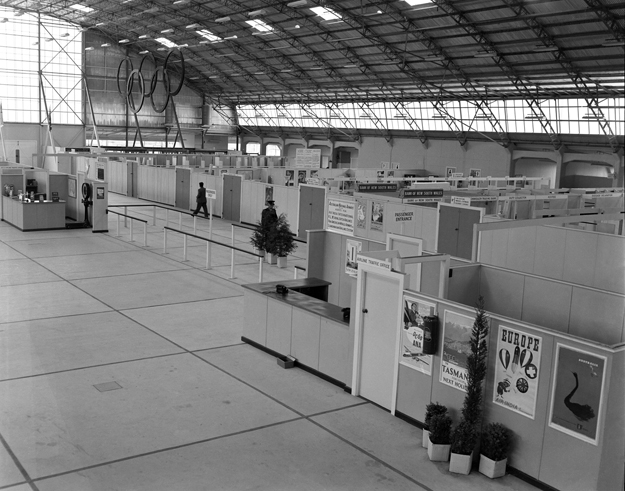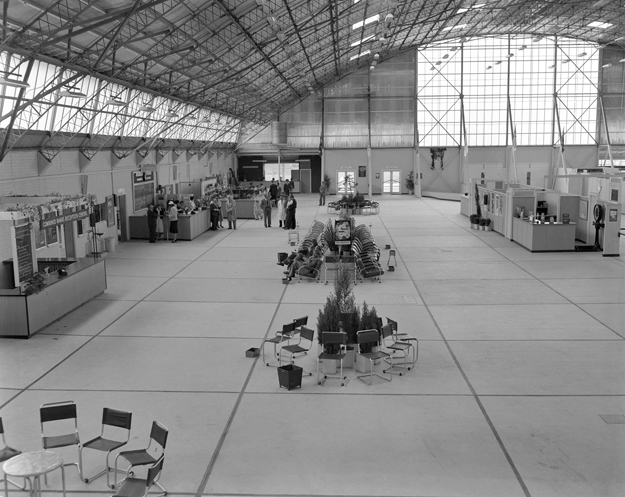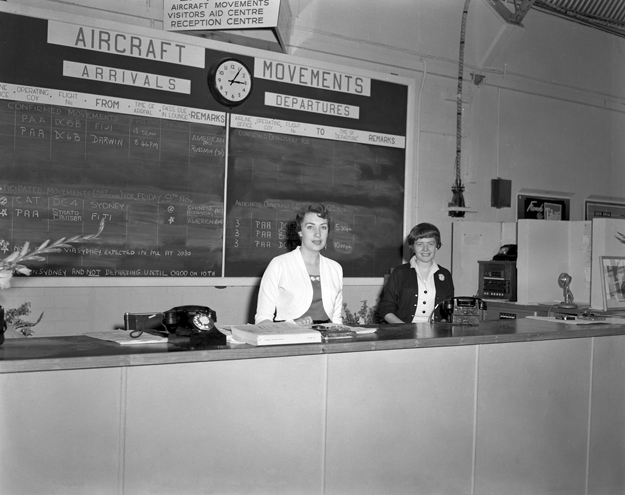At
the time of preparation for the 1956 Melbourne Olympic Games, Melbourne's Essendon
Airport had a modest international terminal which comprised the original 1926
Aero Club building with a Nissan hut attached at the rear. Click here for a
view of these buildings. It was certainly not a suitable international gateway,
even in those days.
In order to provide suitable facilities for the expected influx of competitors and visitors to the Olympics, DCA decided to speed up construction of a spacious new igloo hangar, which was being built at Essendon for ANSETT-ANA, and make that into a temporary International Terminal. The hangar was fitted out with temporary partitions and - of course - a set of plywood Olympic Rings! Customs, Immigration and Health clearance desks were capable of handling 270 passengers at a time. Telephones and teleprinters were installed for the world's press, while such luxuries as postal facilities and a snack bar finished off the appointments. Roads, taxiways, road signs and gardens were all added to cope with the traffic and improve the appearance of the airport.
The Olympic Terminal was officially opened on 31 October at 6.10 am with the arrival of 72 Romanian athletes and one official. The national teams arriving at the airport were greeted by thousands of Melburnians. Most teams arrived in their national dress, with the more regimented contingents marching from their aircraft to the Terminal.
Between 1 November and 21 November 1956 there were 262 extra aircraft movements to Melbourne and Sydney airports involving international traffic. This included a total of 10,729 passengers, 4,276 athletes and officials and 600 international journalists, photographers and broadcasters. At Melbourne (Essendon) Airport, 72 international flights carrying 4,308 passengers were cleared. The remainder were processed in Sydney and then travelled to Melbourne by domestic transport. Swollen by the number of international passengers disembarking in Sydney, the domestic airlines doubled the number of passengers carried from Sydney to Melbourne in the same period to the previous year, raising the number from 10,000 to 20,000.
Twenty world airline operators contributed to the movement of passengers. The ten different types of aircraft used were: Super Constellation; Constellation; Stratocruiser; DC-7C; Armagnac; DC-6B; DC-6; DC-4; DC-3; and Convair 340.
Above and below: Down one side of the 'terminal' were the airline offices, along with the passenger processing areas of customs, etc.

Above and below: The central area of the hangar was transformed into a vast waiting area, or as we would call it today, 'passenger lounge'! Chairs were provided in clusters around rather tiny potted trees for the weary travellers to rest. Just discernible on the far end wall under the window, a patriotic but somewhat pathetically tiny portrait of the Queen gazes over everything.

Below: A booth against the hangar side wall (seen in the distance in the photo above) proclaimed itself the 'Visitor's Aid Centre'. Confirmed arrivals listed for this Friday 9 November 1956 are two Pan Am DC-6Bs, one from Fiji with the American team on board and another from Darwin with - if the board is to be believed - 71 Russians on board. Also anticipated to arrive is a Civil Air Transport DC-4 from Sydney with the Formosan Chinese (Taiwanese) team and a Pan Am Stratocruiser from Fiji via Sydney bringing more Americans. There are no confirmed departures, but the three Pan Am aircraft are anticipated to depart for destinations hidden behind one of the ladies. The Games officially began on 22 November.

The
immensity of the task of Air Traffic Control is illustrated by the movement statistics
for November 21: Melbourne handled 247 aircraft; Sydney 230 aircraft. Melbourne
controlled one movement (take-off or landing) every 3.8 minutes, and for one hour
within that period handled one movement every 2.2 minutes. These were impressive figures for the day, all achieved without the benefit of radar control.
The new (present) Control Tower had just been completed in time for the Games, but had no radar. Furthermore, Essendon did not have a full Instrument Landing System (ILS). It had a wartime Localizer and two marker beacons, but no Glide Path (to provide descent path guidance). In order to provide the Tower with some radar assistance, the RAAF agreed to locate a portable Ground Controlled Approach (GCA) radar unit at Essendon. The GCA was rarely used 'in anger', but it certainly made it possible for the New Zealand contingent to march at the Opening Ceremony of the Games.
By the evening before Opening Day all international contingents had arrived, with one exception - New Zealand. Because of aircraft serviceability problems our closest international competitor was running very late, but eventually advised their ETA of 4am on Opening Day. However, nature intervened. MET issued a fog warning for Melbourne (Essendon) and the alternate airport was Sydney. With the aircraft just 15 minutes from touchdown the fog was getting thicker and the Approach Controller in the Tower was about to close the airport. The pilot of the TEAL aircraft, a DC-4, was asked if he would like GCA assistance to land.
The rest is history. The team just had time to spruce up and make their way to the Melbourne Cricket Ground (MCG) for the Opening Ceremony. It was 22 November and the Duke of Edinburgh, who had arrived in the Royal Convair 440 that morning, officially opened the Games.
The Minister for Civil Aviation, Senator Paltridge, said that it was clear that without air transport the 16th Olympiad would not have been held in Australia. He went on to say that Air Traffic Controllers had borne the greatest 'heat of the day'. "In their highly responsible task these officers have performed magnificently."
Click
here to see a rare colour photo
outside the Olympic Terminal
(Photos: 1,2 & 6-Lindsay Wise via Maurice Austin collection; 3,4,5 & 7-CAHS collection)
Back
to the main Airports &
Aerodromes or Items of General Interest indexes
If
this page appears without menu bars at top and left, click
here